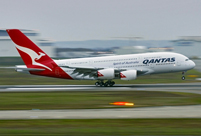KUALA LUMPUR, March 25 -- Malaysia's Acting Transport Minister Hishammuddin Hussein said Tuesday that UK Air Accidents Investigation Branch (AAIB) provided further details as how the data was analysed.
He said Inmarsat, a British satellite telecommunications company, developed a second innovative technique in recent days which considers the velocity of the aircraft relative to the satellite.
According to his words, the Inmarsat technique analyses the difference between the frequency that the ground station expects to receive and one that is actually measured. This difference is the result of the Doppler effect and is known as the Burst Frequency Offset.
"The Burst Frequency Offset changes depending on the location of the aircraft on an arc of possible positions, its direction of travel, and its speed. In order to establish confidence in its theory, Inmarsat checked its predictions using information obtained from six other B777 aircraft flying on the same day in various directions. There was good agreement,"said Hishammuddin.
Yet he also mentioned that while on the ground at the Kuala Lumpur airport, and during the early stage of the flight, MH370 transmitted several messages. "At this stage the location of the aircraft and the satellite were known, so it was possible to calculate system characteristics for the aircraft, satellite, and ground station," he said.
"This analysis by Inmarsat forms the basis for further study to attempt to determine the final position of the aircraft. Accordingly, the Malaysian investigation has set up an international working group, comprising agencies with expertise in satellite communications and aircraft performance, to take this work forward," said the statement.
 Female journalists at 'two sessions'
Female journalists at 'two sessions' Interpreters serving 'two sessions'
Interpreters serving 'two sessions' Female SWAT team in Chongqing
Female SWAT team in Chongqing Top 10 safest airlines in the world
Top 10 safest airlines in the world Old photos of Anti-Japanese War
Old photos of Anti-Japanese War Mysterious 'Dolan Tribe' in Xinjiang
Mysterious 'Dolan Tribe' in Xinjiang A bite of Luoping County
A bite of Luoping County This is Shanghai
This is Shanghai Chinese airborne troops complete parachute training in various training bases
Chinese airborne troops complete parachute training in various training bases Ballerinas anywhere but onstage
Ballerinas anywhere but onstage Most unusual taxis around the world
Most unusual taxis around the world Micro-expression at 'two sessions'
Micro-expression at 'two sessions' Bridge Worship Festival in Taijiang, SW China
Bridge Worship Festival in Taijiang, SW China Hollywood documentary brings Diaoyu Islands truth to new audience
Hollywood documentary brings Diaoyu Islands truth to new audience Miss HK and actresses shine at flower show
Miss HK and actresses shine at flower showDay|Week|Month